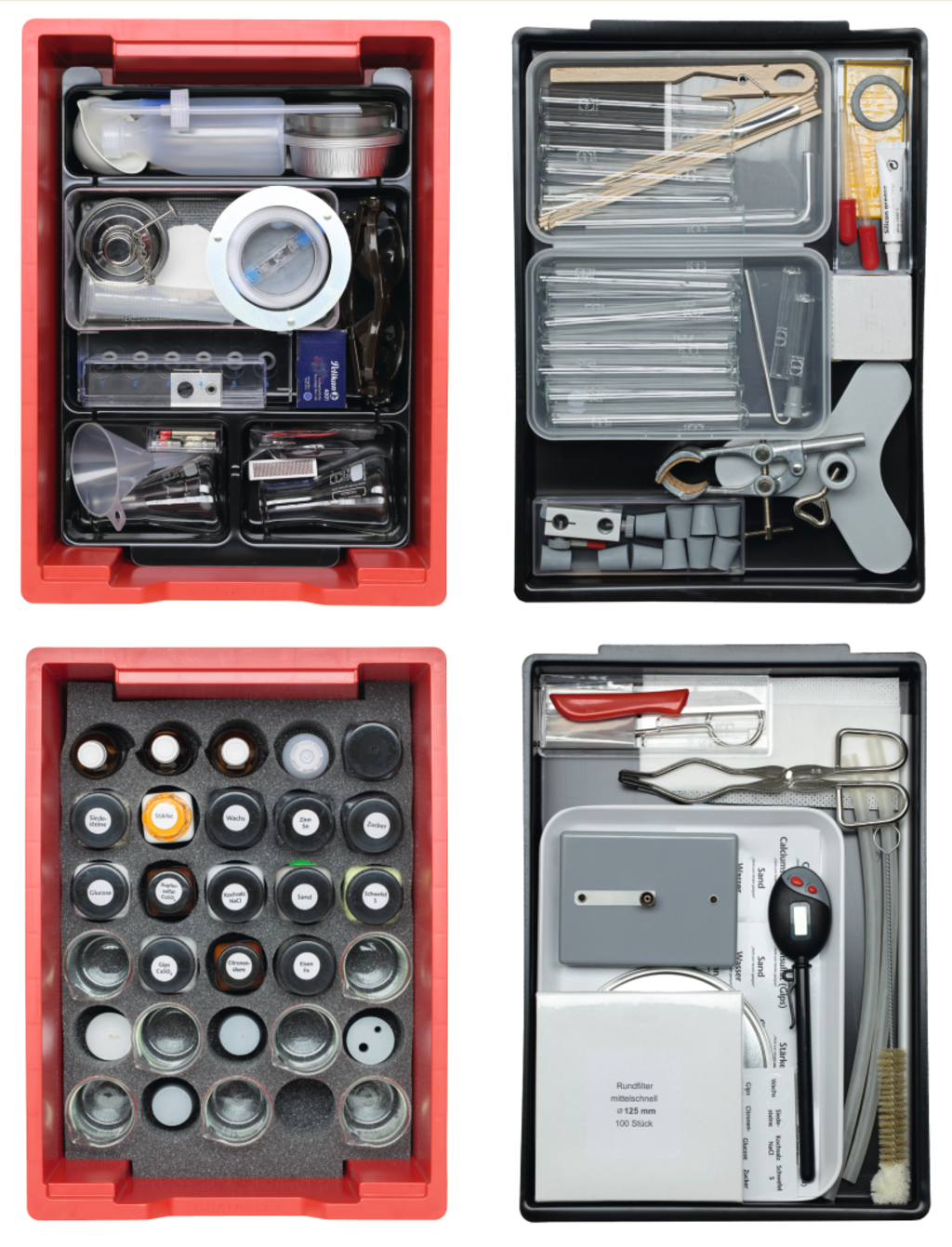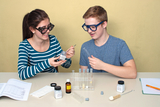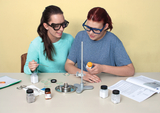Students kit Chemistry I – Substances/mixtures/water
The kit is designed for the elementary instruction. It includes equipment and materials that are needed to conduct fundamental investigations
of materials.
- Substances and their characteristics
- Mixtures and separation of substances
- Composition and characteristics of water
One after the other, a spatula full of glucose, table salt, gypsum, starch, sand and citric acid is closely examined under a magnifying glass.
The students check the solubility of the different substances with water and record this in writing.
Using an electrode bridge that the students build themselves, the electrical conductivity of the liquids prepared in the previous experiment is checked.
The materials are heated by the students with the help of the stand materials and the Bunsen burner and then examined.
The students investigate the distillation of orange juice and can observe exactly what happens in the Erlenmeyer flask, the angle of the glass tube, the hose and the test tube.
The students investigate the distillation of port wine and can observe exactly which processes take place in the Erlenmeyer flask, in the glass tube angle, in the tube and in the test tube.
The students investigate the different states of matter with the help of ice cubes and a spirit burner.
With the help of a water decomposition apparatus, students can investigate the components of water.
The students investigate the electrical conductivity of tap water, distilled water and mineral water.
The students observe the behavior of sugar in water. How does sugar dissolve in cold and warm water? What happens to both solutions when they are heated?
Through this experiment, the students learn about the solubility of substances in oil and in water.
The students learn about the melting temperature and can use the experiment to find out for themselves what the melting temperature of the individual substances can depend on.
The students can use the experiment to observe the behavior of sand and iron powder in relation to the test tube with the magnet.
Students investigate separation processes of substances.
The students investigate the distillation of a copper sulfate solution and can observe exactly which processes take place in the Erlenmeyer flask, in the glass tube angle, in the tube and in the test tube.
Using the spirit burner, students investigate the appearance and temperature of copper sulfate with and without water.
In this experiment, the students can investigate the dissolution processes of sugar in hot and cold water.
The students observe the behavior of table salt in water. How does the salt dissolve in cold and warm water? What happens to both solutions when they are heated?
- 1 × Funnel, PP, 75 mmØ
- 1 × Measuring cylinder, PP, 25 ml
- 1 ×
- 1 × Battery cable, 25 cm
- 2 × Carton for SEG (large tray)
- 2 × Double dish,plastic 80 mm
- 1 ×
- 1 ×
- 1 ×
- 1 × Wooden sticks, 100 pcs. 200x3 mm
- 2 × Safety goggles
- 1 × Digital-thermometer 210x40 mm, -50+300°C
- 1 × O-Ring 3x2,5 mm
- 1 × Foam insert for bottles
- 1 × Tray insert, black 70 mm with 4 partitions
- 2 × Tray insert 35 mm
- 2 × Hinge box, 190x115x40 mm
- 1 ×
- 1 × Waxsheet, 100x40 mm
- 1 × Test tubes rack, perspex 6 tubes with rods
- 1 × Spatula, Micro Powder
- 1 × °Tin, meltingsample
- 1 × Filter paper, circular 125 mmØ, 100 pcs.
- 1 × Evaporating dish, porc. 75mm Ø
- 2 × Rubber stopper 38/31 mm
- 1 × Rubber stopper 38/31mm, 2 holes (6+8mm)
- 1 × Retaining ring 30 mm Ø
- 1 × Dish, aluminium foil, 100 pcs.
- 1 × Triple lens magnifier
- 1 ×
- 1 × Ink, royal blue, 30 ml
- 10 × Watch glass, 50 mm
- 1 × Stirring rod, glass 150 x 6 mm
- 1 × Matches (10 cases)
- 1 × #Plastic box, 59x47x20 mm
- 1 × Plastic box 157x54x19 mm
- 1 × Test tube brush
- 1 × Crucible tongs, stainless
- 1 ×
- 1 × Tube with silicone grease
- 1 × Clamp multipurpose, with short rod
- 1 × °Sand, 100 g
- 3 × Plastic bottle, wide neck100 ml
- 1 × Flask, PE, narrow neck 250 ml
- 1 ×
- 1 × Knife
- 1 × Bulb,MES,4V/0,04 A clear set of 10 pcs.
- 1 × O-ring to 64149
- 1 × Plastic box, 140x50x25mm
- 1 × Pair of carbon-electrodeswith support
- 1 × Copper sulphate, 50 g
- 1 × Flask, PE, narrow neck 50 ml
- 10 × Rubber stopper 18/14 mm
- 1 × Plug lead, 50 cm, black
- 1 × Sulphur, powder 99%, 50 g
- 1 × Paper, black
- 1 × Instrument tray,268x208mm
- 1 × °Sodium chloride, 100 g
- 1 × Vegetable oil, 50 ml
- 1 × °Calcium sulphate, 50 g
- 1 × °Glucose, 50 g
- 2 × Dropping bottle, 50 ml
- 1 × Starch, soluble, 25 g
- 1 × Trough, plastic transp. 210x110x80 mm
- 2 × Dropping pipette, plastic
- 1 × Bosshead with slit
- 1 × Tripod stand, 80 mm
- 1 × °Iron powder, 100 g
- 2 × Storing tray, deep, red
- 1 × Citric acid-1-hydrate 25g
- 1 × °Boiling stones 40 g
- 1 × Battery cell, 9 V, 6F22
- 1 × Magnet rod, AlNiCo, 23 mmwith red-marked northpole
- 1 × Heat protection gauze
- 1 × Tripod stand
- 1 ×
- 1 × Metal plate, 150 mmØ
- 1 × Test tube holder, wood
- 1 × Silicone tubing, 7/1,5 mmper m
- 1 × Spirit burner, metal
- 2 × Lid for 75028 + 75038
- 1 × Plastic box 140/50/35 mm
- 2 × SEG Lidfoam, grey 10 mm
- 1 × Glass tube,special angled50x150 mm
- 1 × Lampholder MES on base
- 1 × Gas voltameter, student
- 1 ×
- 1 ×
- 1 ×
- 2 ×
- 1 ×
- 7 ×
- 1 × Rubber stopper 13/09 withangled rod






